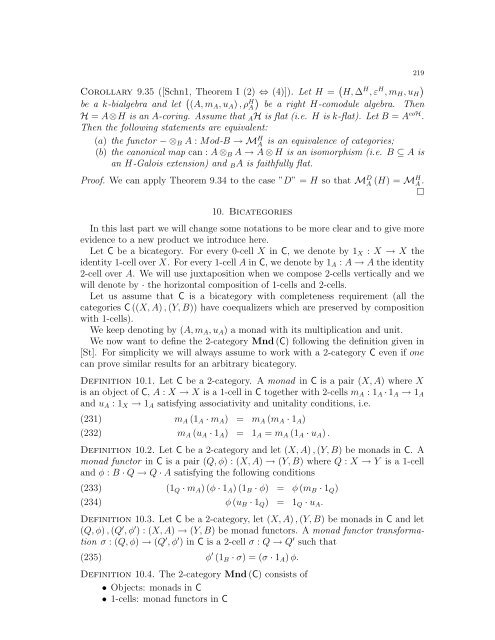Contents 1. Introduction 2 2. Preliminaries 4 2.1. Some results on ...
Contents 1. Introduction 2 2. Preliminaries 4 2.1. Some results on ...
Contents 1. Introduction 2 2. Preliminaries 4 2.1. Some results on ...
Create successful ePaper yourself
Turn your PDF publications into a flip-book with our unique Google optimized e-Paper software.
219Corollary 9.35 ([Schn1, Theorem I (2) ⇔ (4)]). Let H = ( )H, ∆ H , ε H , m H , u Hbe a k-bialgebra and let ( )(A, m A , u A ) , ρ H A be a right H-comodule algebra. ThenH = A⊗H is an A-coring. Assume that A H is flat (i.e. H is k-flat). Let B = A coH .Then the following statements are equivalent:(a) the functor − ⊗ B A : Mod-B → M H A is an equivalence of categories;(b) the can<strong>on</strong>ical map can : A ⊗ B A → A ⊗ H is an isomorphism (i.e. B ⊆ A isan H-Galois extensi<strong>on</strong>) and B A is faithfully flat.Proof. We can apply Theorem 9.34 to the case ”D” = H so that M D A (H) = MH A .□10. BicategoriesIn this last part we will change some notati<strong>on</strong>s to be more clear and to give moreevidence to a new product we introduce here.Let C be a bicategory. For every 0-cell X in C, we denote by 1 X : X → X theidentity 1-cell over X. For every 1-cell A in C, we denote by 1 A : A → A the identity2-cell over A. We will use juxtapositi<strong>on</strong> when we compose 2-cells vertically and wewill denote by · the horiz<strong>on</strong>tal compositi<strong>on</strong> of 1-cells and 2-cells.Let us assume that C is a bicategory with completeness requirement (all thecategories C ((X, A) , (Y, B)) have coequalizers which are preserved by compositi<strong>on</strong>with 1-cells).We keep denoting by (A, m A , u A ) a m<strong>on</strong>ad with its multiplicati<strong>on</strong> and unit.We now want to define the 2-category Mnd (C) following the definiti<strong>on</strong> given in[St]. For simplicity we will always assume to work with a 2-category C even if <strong>on</strong>ecan prove similar <str<strong>on</strong>g>results</str<strong>on</strong>g> for an arbitrary bicategory.Definiti<strong>on</strong> 10.<str<strong>on</strong>g>1.</str<strong>on</strong>g> Let C be a 2-category. A m<strong>on</strong>ad in C is a pair (X, A) where Xis an object of C, A : X → X is a 1-cell in C together with 2-cells m A : 1 A · 1 A → 1 Aand u A : 1 X → 1 A satisfying associativity and unitality c<strong>on</strong>diti<strong>on</strong>s, i.e.(231)(232)m A (1 A · m A ) = m A (m A · 1 A )m A (u A · 1 A ) = 1 A = m A (1 A · u A ) .Definiti<strong>on</strong> 10.<str<strong>on</strong>g>2.</str<strong>on</strong>g> Let C be a 2-category and let (X, A) , (Y, B) be m<strong>on</strong>ads in C. Am<strong>on</strong>ad functor in C is a pair (Q, φ) : (X, A) → (Y, B) where Q : X → Y is a 1-celland φ : B · Q → Q · A satisfying the following c<strong>on</strong>diti<strong>on</strong>s(233)(234)(1 Q · m A ) (φ · 1 A ) (1 B · φ) = φ (m B · 1 Q )φ (u B · 1 Q ) = 1 Q · u A .Definiti<strong>on</strong> 10.3. Let C be a 2-category, let (X, A) , (Y, B) be m<strong>on</strong>ads in C and let(Q, φ) , (Q ′ , φ ′ ) : (X, A) → (Y, B) be m<strong>on</strong>ad functors. A m<strong>on</strong>ad functor transformati<strong>on</strong>σ : (Q, φ) → (Q ′ , φ ′ ) in C is a 2-cell σ : Q → Q ′ such that(235) φ ′ (1 B · σ) = (σ · 1 A ) φ.Definiti<strong>on</strong> 10.4. The 2-category Mnd (C) c<strong>on</strong>sists of• Objects: m<strong>on</strong>ads in C• 1-cells: m<strong>on</strong>ad functors in C
















